Shrimp are a beautiful and entertaining addition to your saltwater tank and by having just a couple of these characters in your tank will help to dramatically increase your viewing pleasure! Most of the shrimp are super easy to care for and this is why many hobbyists love to have them in their aquarium, I know I do!
Not only do shrimp add some nice visual diversity they also work as fantastic members to your clean-up-crew. Being mostly scavengers shrimp will set up home in their favorite spot in the tank and then wander looking for food.
By helping to keep uneaten food, fish waste, and dead animal matter under control the shrimp help to maintain higher water quality which is a win-win for everyone!
Some the Best Saltwater Shrimp for Beginners’ Aquariums Are:
- Harlequin Shrimp
- Peppermint Shrimp
- Camel Shrimp
- Scarlet/Skunk Cleaner Shrimp
- Blood Red Fire Shrimp
- Sexy Anemone Shrimp
- Banded Coral Shrimp
- Saron Shrimp
- Bumblebee Shrimp
Harlequin Shrimp
(Hymenocera elegans)
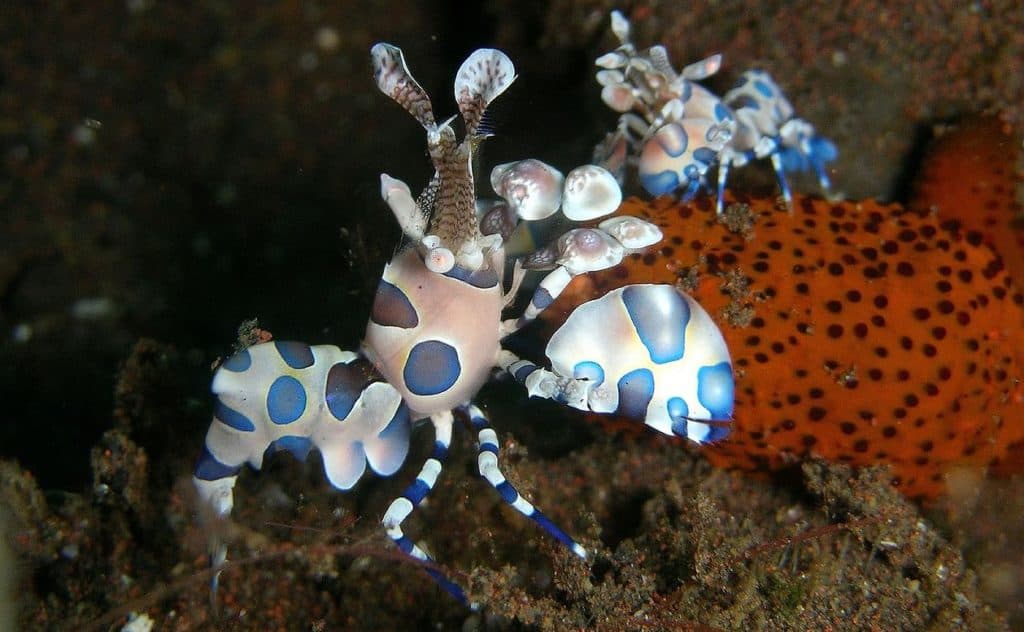
Prices Range From $50
This shrimp is from the Pacific and Indian Oceans and belongs to the Palaemonid family and is a very fine choice for your saltwater aquarium setup.
They have an incredibly bewitching appearance with their white or cream color bodies and purple, blue or red spots making them look like a work of art, hence it is also called painted shrimp.
This shrimp is a scavenger and can eat anything but they absolutely love eating starfish. Now, this shrimp is not a good option if you have or wish to keep a starfish, but it will devour any Asterina Starfish, which is a coral parasite, thus protecting your corals.
They are shy when coming into the new aquarium and will take their time adjusting to it, so don’t be afraid if you add it and then don’t see it for a while! Eventually, you can usually find them hiding in a rock cave for which they call home, and use it for shelter and protection.
Although they are friendly with other tank mates, they can be aggressive towards their own species, so it is not advisable to keep them in groups but better keep alone, or in a mated pair.
They can grow to 2 inches so can easily be kept in a 10-gallon tank.
Peppermint Shrimp
(Lysmata wurdemanni complex)
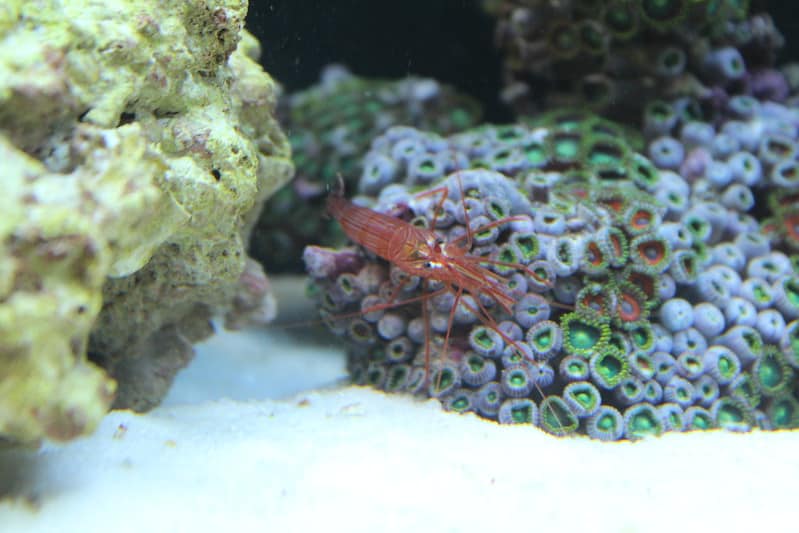
Around $10
This little beauty belongs to the family Hippolytidae is often called veined shrimp, Caribbean cleaner shrimp, Candy Cane Shrimp, or Sweeper shrimp.
They are very useful for keeping in the aquarium as they love to hunt the dreaded pest known as Aiptasia; the glass anemones. These anemones reproduce at high rates, overrun real-estate for coral and can sting fish in the tank.
This shrimp is mostly nocturnal, staying hidden in the rocks and cervices to only come out at feeding time, but over time will become used to your dayly aquarium life and start to swim freely searching for food. Their bodies are brightly colored, somewhat translucid with pink to red stripes.
It is a carnivore and will become a major part of your clean-up-crew. They will eat leftover organic matter, dead fish tissue, and detritus to help clean the tank.
This shrimp is usually civilized and pleasant with other tank members but be mindful because it can be hostile towards its own species so have one in a small tank or a few in the large tank.
They can grow up to 2 inches in size and again perfect for Nano Tanks.
Camel Shrimp
(Rhynchocinetes uritai)
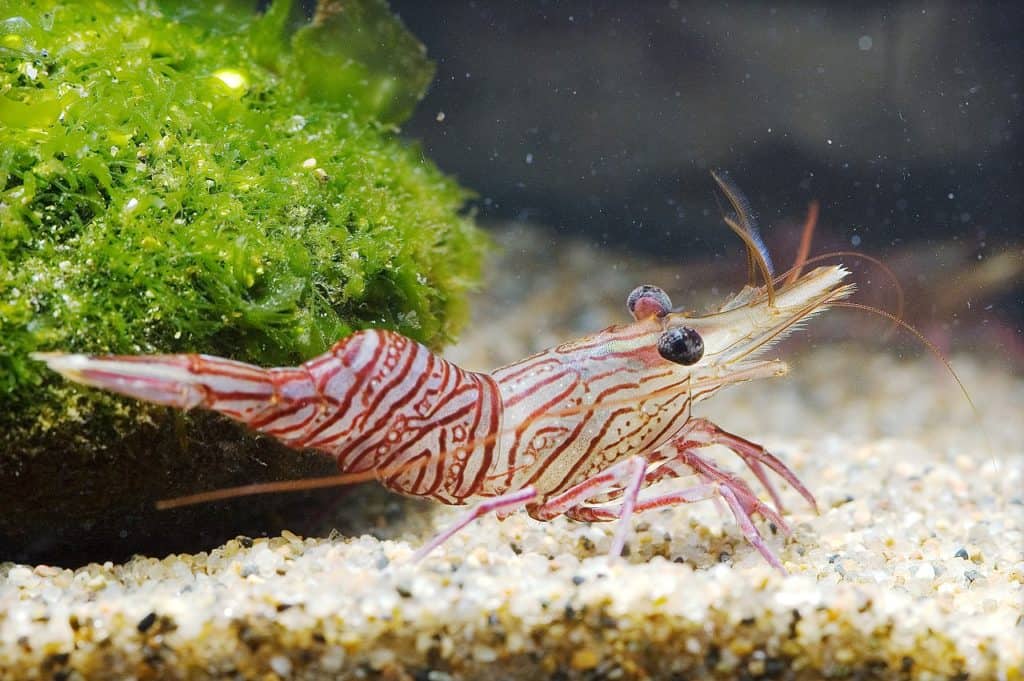
Around $15
This shrimp is native to Australia, East Pacific, East Indian Ocean, Indonesia, and central/west Pacific and belongs to Rhynchocinetidae family.
They are named Camel shrimp because of their distinctive hump just like a camel. They are also called hinge beak shrimp because of containing a beak or rostrum which most of the time pointed skywards. Other names of this shrimp are candy shrimp and dancing shrimp. They have large eyes which helps them move around in a low-light environment as they are mainly a nocturnal member of the tank.
Their bodies contain very vibrant, bright cherry-red colored stripes so sometimes they can be mistaken for peppermint shrimp, but their hump easily differentiates between both of them.
This shrimp is a very good tank cleaner as it eats debris and other waste matter. This shrimp is very friendly and amicable with other fish, invertebrates, and their own species, so you can easily put them as a colony of 4 to 6 individuals in a large tank.
Due to its quiet and calm nature, it can be a target for predators so pay attention to any fish which can be known to prey on shrimp, especially Hawkfish.
In the aquarium, their diet is mostly omnivorous so you should feed them with diverse foods like vitamin-rich flakes, frozen plankton, crustacean larvae, clams, and mussels if your tank is fairly unmatured.
Due to all these mentioned factors, they can be slightly difficult to care for when your aquarium is new, but once matured and lots of algae and livestock have been in for a year they will do great.
They can grow a maximum of 2 inches and you can put one of them in a 10-gallon tank.
Scarlet Cleaner Shrimp
(Lysmata amboinensis)
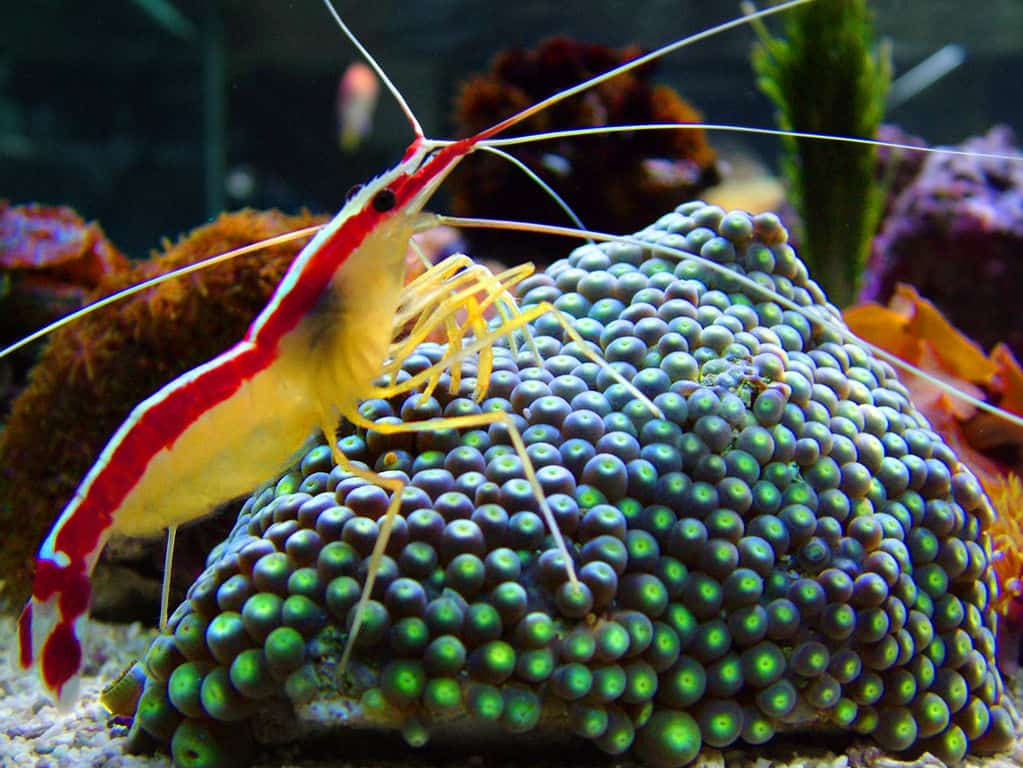
From Around $35
This shrimp is from the Indo-pacific region and belongs to the Hippolytidae family. It is one of the most famous and graceful creatures you will find in many reef aquariums.
Its body color is yellow with striking red and white stripes with very long white antenna that you will usually see sticking out of a rock cave, long before you see the shrimp itself!
This shrimp gets its name by setting up a station on a piece of rock and gives grooming assistance to the fish by cleaning their bodies, fins, and even mouth. It eats dead tissue and any parasites it can find and in exchange for this service, fish do not try to prey upon the shrimp, which makes this relationship a symbiotic one.
My Yellow Tang is one of my Cleaner Shrimps favorite customers!
Any predatory saltwater fish is not compatible with this shrimp so avoid keeping both of them in the same aquarium. It is an omnivore and can eat any type of food, sometimes it can even munch on corals so keep an eye out for their behavior. They will swim and climb on you when your hands are in the tank and it’s interesting to feel them picking away at your nail cuticles!
They can grow to 2 inches and again, perfect for any size aquarium.
Blood Red Fire Shrimp
(Lysmata debelius)
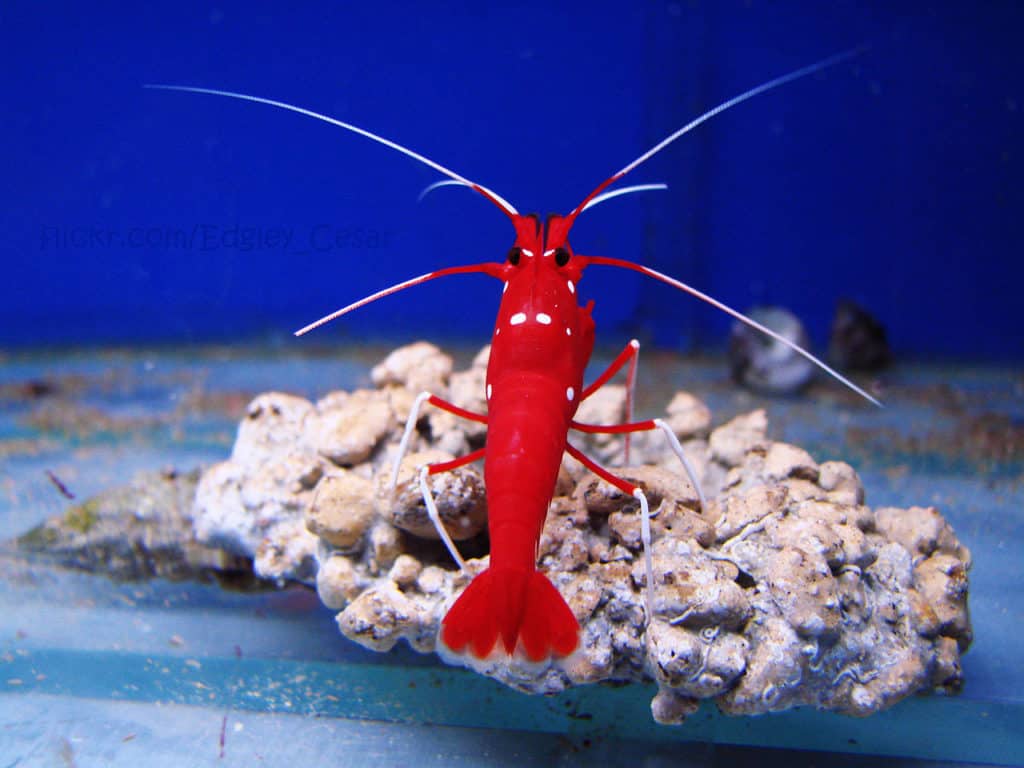
Starting Around $45
Originating from Indo-pacific regions blood-red fire shrimp is by far the most exquisite, elegant, and popular of all shrimp, but you can pay a hefty price for one!
It is also known as Fire Shrimp, Blood Shrimp, and Scarlet Shrimp because of its blood-red colors and long antennae. It is effortless to keep them because they don’t require any special requirements in your tank only that; it doesn’t like intense lighting so you will usually find them under a ledge or in a cave.
To help with this, if you set up a cave facing the front of the tank when you layout your aquascape, you can ensure this beauty is seen instead of hiding around the back!
They are usually calm and pleasant with other tank mates (providing they don’t encroach in its territory) but can get intolerant towards their own species. They are great to be kept in pairs in a tank of +55 gallons.
Be sure to house these without Marine Bettas, Hawkfish, and bigger fish that can eat them without a second thought.
This shrimp is part of the cleaning and scavenger crew and lurks at the bottom of the tank searching for meaty chunks and leftover food.
When fully accustom to your tank it will also establish a cleaning site where it gives special cleaning services clearing away parasites and dead tissues from fish fins and gills.
They can grow up to 3 inches with only one housed in a tank of 20g or more.
Sexy Anemone Shrimp
(Thor amboinensis)
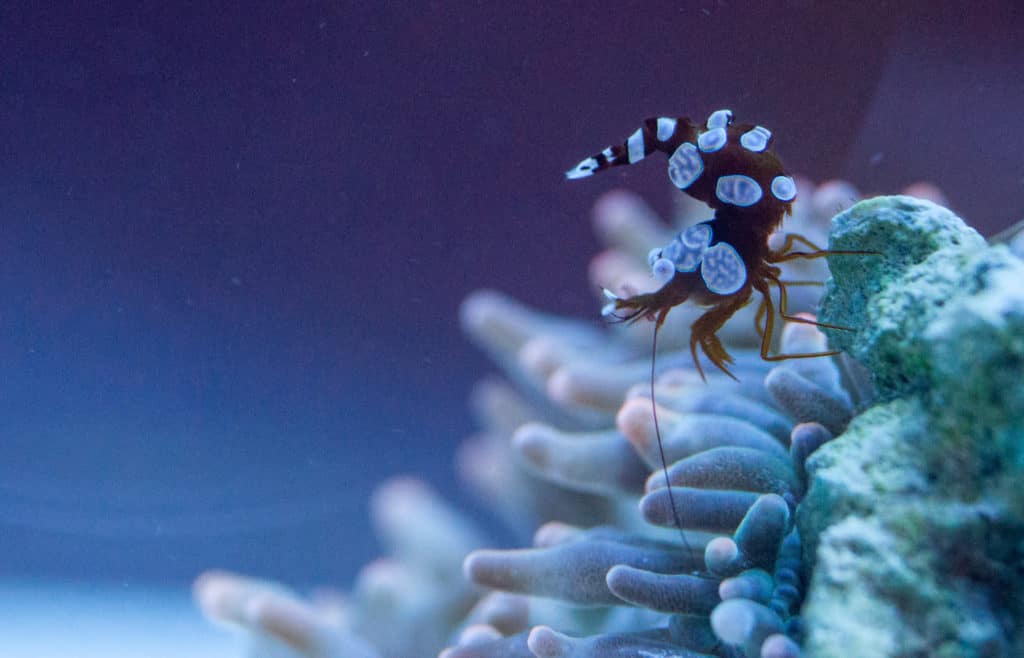
From Around $15
This shrimp owns the title of being among the cutest of all invertebrates having a very faraway enchanting look with their reddish-brown spots and exotic behavior. They are called sexy shrimp because of their walking and waving or their abdomens.
They originate from the indo-pacific region and belongs to the Hippolytidae family. It usually prefers living among anemone tentacles in the wild, but in the aquarium, you will see it sitting on rock outcroppings or rummaging through the sandbed in search of food.
This shrimp has a symbiotic relationship with anemone’s, especially Carpet Anemones because they provide it protection and in return, it assists them in cleaning.
This shrimp is an omnivore and will scavenge for any meaty morsel or can be seen picking away at bits of algae it finds. Besides being beautiful, it also shows friendly behavior with other tank mates so, to keep them happy and healthy you should put it in groups and feed them a diverse diet consisting of plankton, meat, and frozen bits.
Because of their micro size, they are best suited to nano and pico aquariums to not only keep it safe from hungry mouths but placing these in a large aquarium may be the last time you ever see it! One other thing to keep in mind is that this shrimp is very docile so be sure to place it in a peaceful aquarium for the greatest chances of success.
They can grow to 1-1/2 inches in size.
Banded Coral Shrimp
(Stenopus hispidus)
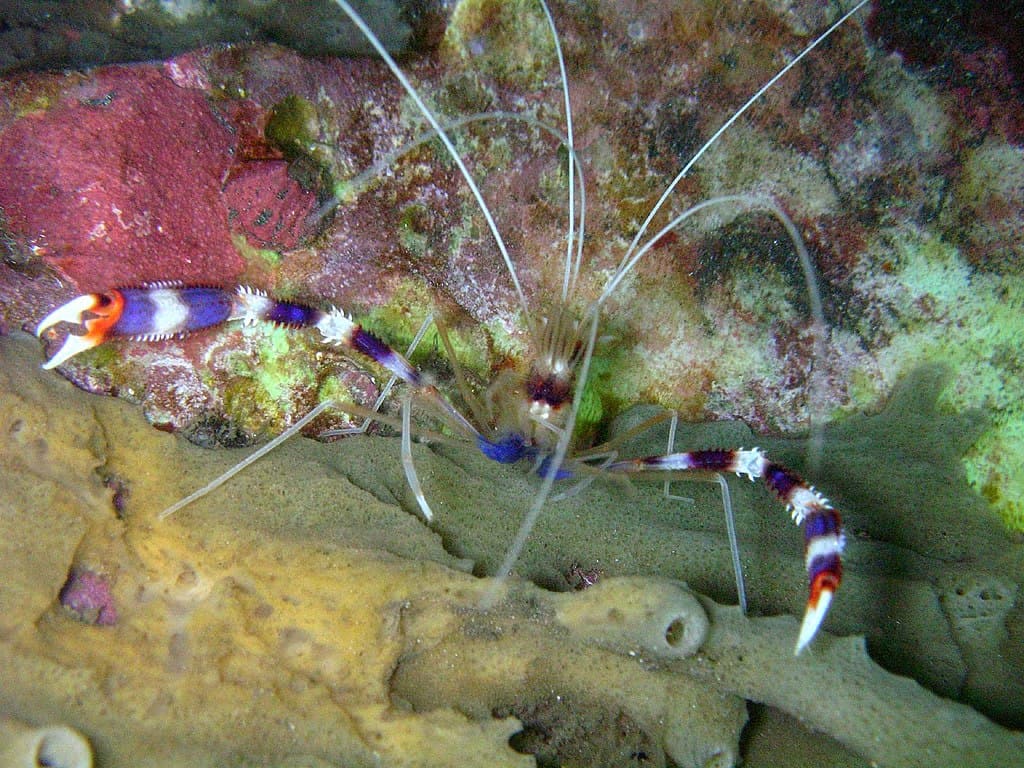
Starting Around $15
This beautiful red, white, and blue banded creature with its long antennae and pinchers belong to the family Stenopodidae which are predominantly scattered throughout the Indonesian ocean.
It can be also found under the names of a Banded Cleaner, Boxing or Coral Shrimp. It usually keeps its pinchers erect giving the impression that it is ready for a fight, hence the name Boxing shrimp and It has an active personality as it is seen scurrying around the tank searching for food.
My shrimp, along with most of the banded shrimp like to be found dangling upside down in their favorite cave or under a rock so make sure you have a lot of live rock with and hiding places in your tank for this beauty. Another reason to build in a hiding place you can see these shrimp in!
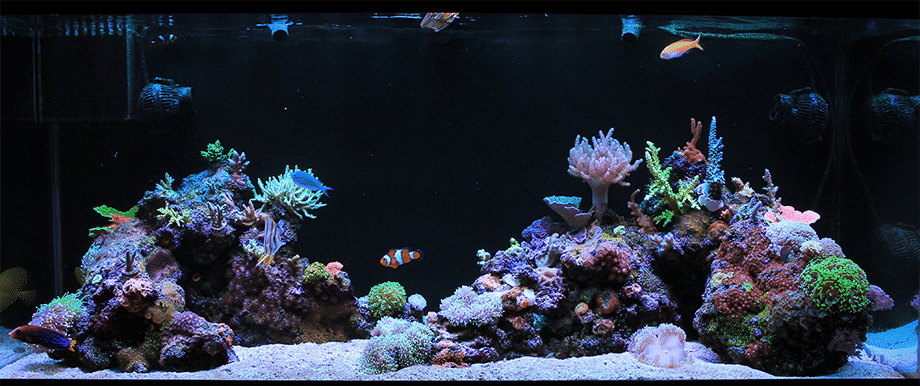
It will live peacefully with other tank mates but make sure you don’t have any slow-moving invertebrates, be sure to keep an eye on your snail population as sometimes these shrimp are opportunist predators on them.
This one is also shown to be offensive towards its own species so it is advisable to keep only one or a mated pair in your tank to prevent any fighting.
This shrimp usually grow up to 3 inches in size and with antennae, it will reach up to 6 inches so a minimum 30-gallon tank size is advised. It is an omnivore and can eat a variety of foods and also helps in cleaning the aquarium from dead tissues, fungus, and parasites.
Saron Shrimp
(Saron marmoratus)
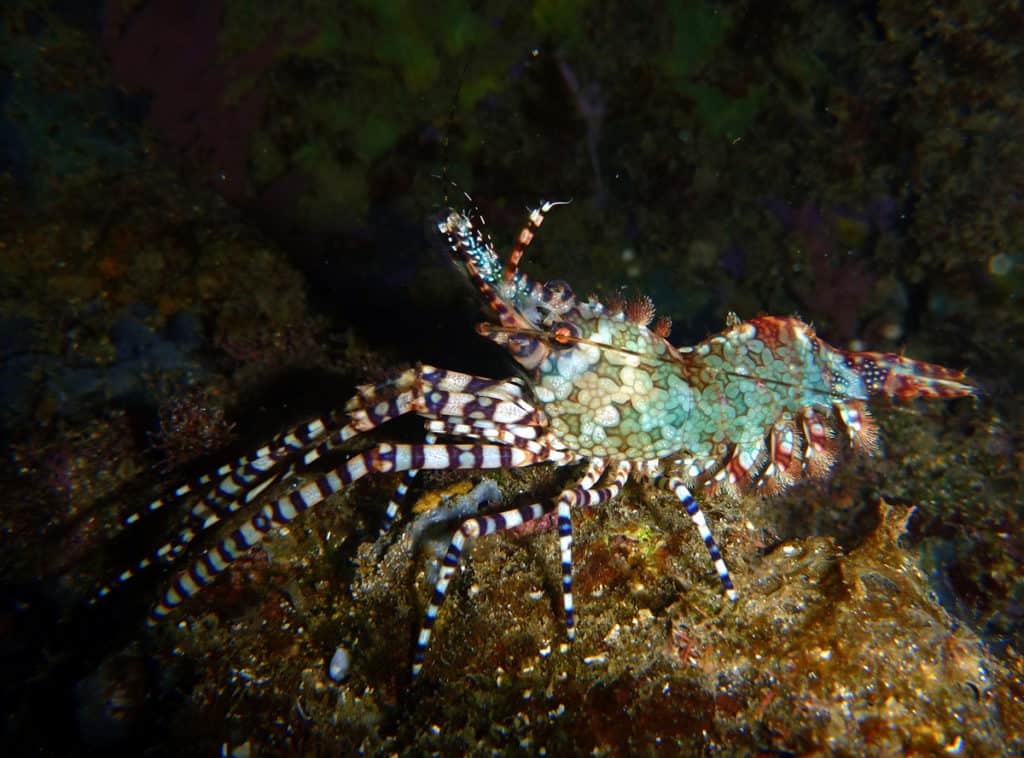
Starting Around $5
This one is perfect for beginner to advanced saltwater aquariums alike. It originates from Indonesia, Hawaii, Maldives and is also know as the Monkey shrimp, Buffalo shrimp, and Marble shrimp. It belongs to Hippolytidae family and is mainly a nocturnal creature.
It has a fantastic ability to change colors; green color in the day and red during the night which it uses to help stay hidden in the shadows when in the wild. Tufts of cirri are present in the males distinguishing them from females and either are suited for the aquarium.
It is easy to keep and care for but it will take a slow adjustment to your aquarium before it feels comfortable to begin roaming around during the day, so ensure your tank has lots of dark hiding places because in the start, it will only show up at night.
It can usually be found on the bottom of the tank scavenging and eating leftover dead organic matter but once happy it will also feed on the usual with frozen foods that you feed your fish.
It can grow a maximum of 2 inches in size and can be kept in a +20-gallon tank.
Bumblebee Shrimp
(Gnathophyllum americanum)
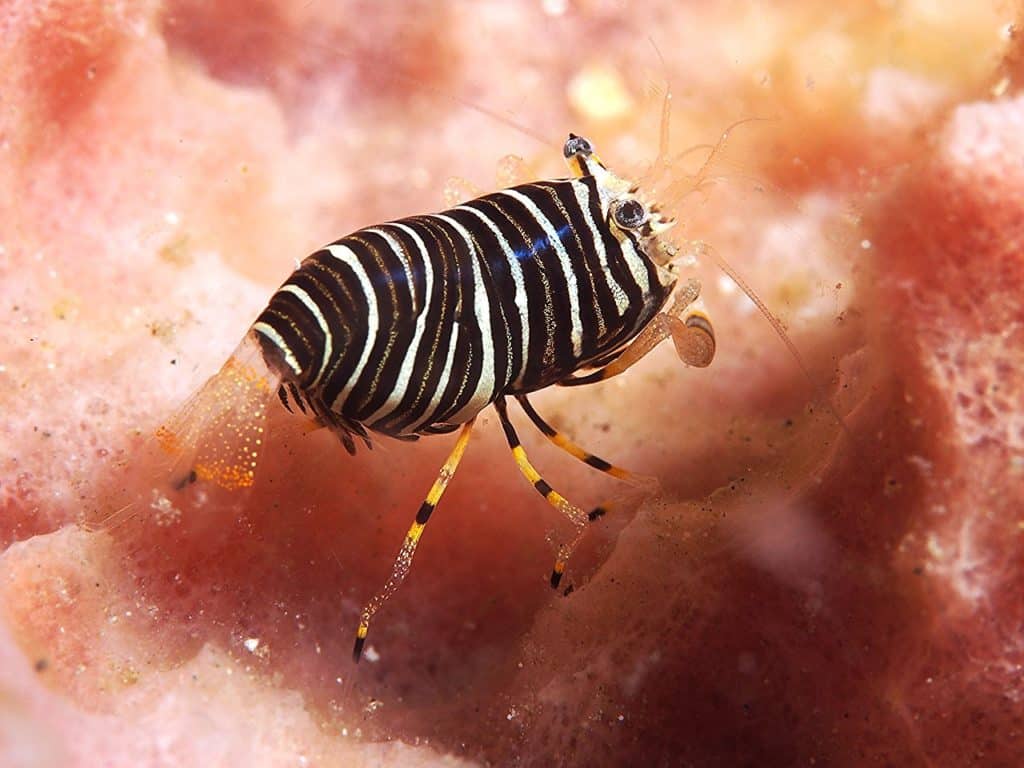
Priced Around $15
This shrimp has a very striking appearance which gives it its name. It can also be called the Stripe Harlequin shrimp and is somewhat similar to Harlequin shrimp. It is present all over the Indo-Pacific region and belongs to Gnathophyllidae family.
It is very small, growing only to around 1 inch that is why it is well suited for nano aquariums! Its body is tan, white, orange, or yellow with black stripes giving it the resemblance to a bumblebee.
A minimum 10-gallon tank will be required for this shrimp and it is never aggressive and always friendly with the tank mates but the risk of getting eaten by the bigger fish is there due to its small size, so peaceful tank mates are a must. This shrimp will need lots of rockwork where it can easily hide when feeling vulnerable or in case of predatory attack from other fish.
To Finish
Keeping shrimp in a saltwater aquarium has great benefits, aside from visually diversifying your aquarium, they will also eat pests and detritus keeping the tank water clean.
Most of these shrimp are omnivores and scavengers so they will eat anything they can find and any supplemental feeding they get will come from the food your feed your fish anyway.
They also do not trouble other tank members and mostly keep to themselves. There are not any reports of shrimps being affected by any kind of parasite or any sickness but they do need oxygenated water for their great health.
As always, prior research is required before choosing a shrimp species for your aquarium to ensure it doesn’t become a meal the second you add them into your aquarium. They can be added soon after your tank has cycled, just be sure to provide them with food if your tank is still sterile and unmatured!
Further Reading
If you found this article useful, I highly recommend these other ones too:

